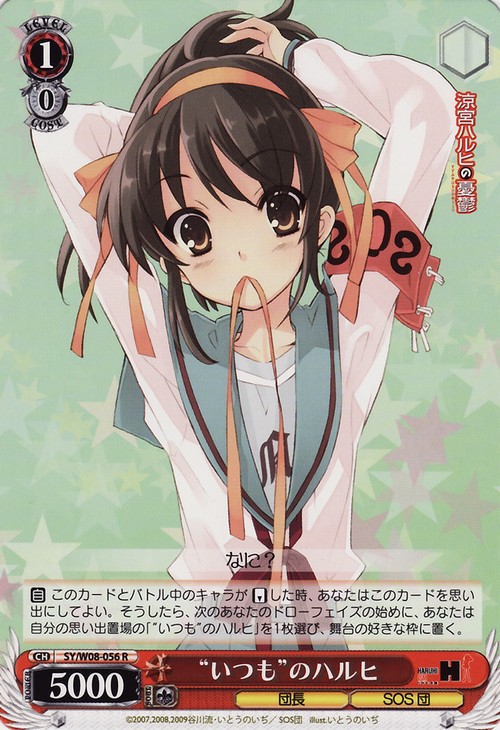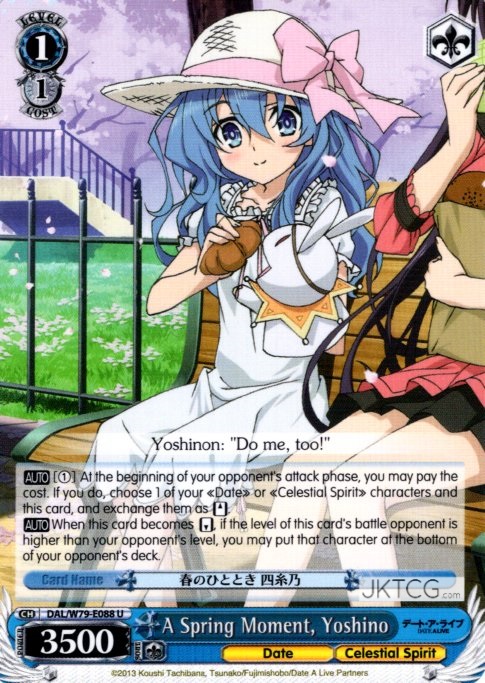Weiss is a game based on anime. As someone who tends to the competitive side of the game, I find it’s easy to forget that fact. However, taking that step back can show us what really matters in this game[1]. In my mind, it’s having fun and making sure everyone knows your waifu/husbando/bearfu/giant insectfu[2] is the best[3]!
Silliness aside, building waifu decks brings together two of my favourite parts about Weiss. Objective based deckbuilding and the fact that it is based on anime. The objective here is to make the best damn version of your waifu deck you can or use cards that feature your favourite scenes or art of the character. Waifu building provides a lot of fun options that aren’t top of mind when building for competitive play. We’ll start by looking at how to approach building waifu decks, why I think it’s fun, and by the end I hope to have convinced you to play a Sheryl Nome Macross Frontier deck.
How to build Waifu
There are two common ways to build a waifu deck. The first is what I refer to as “soft waifu”, where you allow yourself to use a few cards that don’t feature your waifu, their equipment, or pets. This allows for more diverse builds. It often allows side characters, like friends or family, that support your waifu to support them in the deck as well. The second is what I term hard waifu, where you limit yourself to only your waifu, their equipment, and any pets they may have[4]. Both present an interesting deck building challenge and different flavour.
I’ll go over how to build both types of decks. They both start the same way:
Step 1: Have a waifu.
Step 1a: If you don’t have a waifu, watch Macross Frontier.
Hard Waifu (Only the waifu, and her equipment/pets)
Whether I’m building a deck with the hard restrictions or the softer restrictions, I find it useful to initially approach the deck building project as if you are abiding by the stricter restrictions. This helps you in a few ways that I hope will become apparent as we build the deck.
Before we actually start building the deck, we need to figure out if we can. Find every card that features your waifu that can be played together in the neo-standard format[5]. This lets us know two things: are there sufficient cards to make legal deck based around your, and how your waifu works in Weiss. Sadly, it isn’t always possible to build a deck around your waifu. For example, there are only nine regular cards that feature Hiyori from Lucky*Star and none of which are swarm characters. You can only fill 36 slots of the required 50. There aren’t enough cards for a strict waifu rules deck. This is common when your waifu is a side character.
Once you’ve rounded up all the cards with your character on them, it’s now time to make some decisions. First, we want to determine our true deck objective. There are three that immediately jump to my head. Given the strict waifu constraints, do you: maximize competitive viability, maximize deck flavour, or maximize aesthetic. By self imposing waifu restrictions you already preclude maximizing competitive viability immediately by not including a bunch of good cards in your deck, so I suggest ignoring that as an objective. Thus, we focus on going max flavour or max aesthetic and use a minimum level of viability as a constraint. After all, you wouldn’t want your waifu deck to be trash, would you? That might suggest something.
What’s the difference between flavour and aesthetic? It’s subtle, and for many sets it may not actually exist. The flavour of the set, commonly, refers to whether the mechanics of the set match the series the set is based on. Does playing the set feel sort of like the watching the show? For instance, Usual Haruhi, which jumps to memory when it defeats a character and returns next turn, is a very flavourful card given the reality bending nature of The Melancholy of Haruhi Suzumiya. Spring Moment Yoshino is another, where a skittish character becomes a card that can switch places with another character. On the other hand, the aesthetic refers to the look and feel. Is the art pretty? Does it bring out the best in your waifu? Are your favourite scenes of your waifu included? Does the flavour fit the imagery chosen on the card? When done well, flavour and aesthetic are part and parcel.


Truly, building a waifu deck is an exercise in aesthetics.
Typically, if the aesthetics and flavour are in discord, I tend to lean to flavour. I’m playing a card game; I want the mechanics to feel right. Thus, when I’m building a waifu deck I tend to look at whether you can see a relation between the character’s abilities and the cards printed.
This leads me to an interesting choice in larger sets: do I go with the best characters printed for my character, or do I go for the most flavourful? Typically, I’ll go for the flavor approach first. This is an exercise in unusual deck building here. If things don’t work out, I can always go back and restructure. Knowing that, the deck construction process moves in a somewhat orthodox direction.
- Now that I’ve identified the flavourful cards I want to work with, I determine the deck objective. How does my waifu deck intend to win games? Do attempt to set up a particular flavourful finish, do I wall out and do weird stuff, odd event abuse, or do I rush?
- From there, I know how to structure the deck at each level and what climax cards to choose. For instance, if I’m basing the deck around specific combos, I structure the deck to maximize the chance of me successfully finding the combo, facilitating the resources to deploy the combo, and ensuring I’m in a place to win if I succeed in getting off the combo. If the set permits, I’ll also play cards that get bonus value when the specific trigger is hit. If I’m building a standby deck, I’m looking for a good backrow card, good beat sticks at level 1 and 2, and level 0s to get specific cards into discard and increase my chance of getting my field set up early.
- Do an internal consistency check. Review if what I’ve built meets my objectives: is it sufficiently flavorful, does it follow the gameplan, and does it have immediate glaring issues? I then address the build if it does not meet criteria or proceed to play a few fun games.
I then iterate these steps to get to something that both works and is probably the best bet to succeed. I haven’t personally uploaded an example of a hard waifu build, but Kira’s Kill La Kill build is illustrative.
Soft Waifu (mostly waifu, plus some other techs)
With soft waifu, the building constraint relaxes a bit by allowing other characters. It comes a new problem: How many cards that aren’t the waifu constitute too many? Obviously, if half the deck isn’t that character, it’s probably fair to suggest that you’re playing a Weiss deck from that set and not a waifu deck. Other people have previously opined on the matter, but I tend to be a bit more dovish overall, if I’m not building for a tournament with a particular deck content rule set. I’ll usually call a deck I’m making a waifu deck if at least 80% (40+) of the cards in the deck are the same character.
The deck building strategy is mostly the same as a hard waifu build, however, I pay more careful attention to the flavour and aesthetics. One of the hardest considerations here is whether it’s worth including a very good utility card into the deck even if the two characters are enemies or don’t really interact. It’s another area where trading off deck quality for aesthetics arises. Typically, I err on the side of the aesthetics but sometimes the utility is so good that you can’t leave it out. My Sheryl Nome Macross Frontier build is an example of a softer approach. I made one choice of utility over aesthetic, by including the tap self salvage brainstorm. Canaria and Sheryl almost never interact.
Why is Waifu fun
So, I’ve told you how to build a deck with a bunch of arbitrary restrictions. What’s fun about doing all of this? For me, it’s fun for a variety of reasons. First, it’s a conversation piece. It gives me an excuse to talk about my favourite series with other players when they ask about the particulars of the deck. Hopefully, they’ll either have watched the show and we can have a fun conversation, or I may have at least convinced them to give Macross Frontier a watch.
Related to this point, playing a deck that has some of my favourite scenes from my favourite shows reminds me that I’m playing a game based on anime. It’s nice just to take a second and step back when playing a game with your buddies and think about why you like the series and the character.
Finally, it encourages you to play decks that you wouldn’t normally try. Weiss has many different play styles to offer, but I find that I tend to stick with more defensive decks that match my natural playstyle. Some of my favourite characters, however, tend toward more aggressive decks. It’s a fun way to try out something that might be out of your normal style of play. Who knows, you might get a new appreciation for setting up a big combo, standby, or another style of play you don’t usually subscribe to. For all these reasons, I think it’s worth giving waifu builds a go, at least at a friendly tournament.
[1] And life, really.
[2] For brevity, I’ll use waifu going forward. Do keep the mental image of a an array including a bear in your head though.
[3] Did anyone think I was truly above waifu wars?
[4] Some people will even preclude the pets if the character’s name isn’t in the card.
[5] You could play waifu in Standard Format, but that would be very unfun. This is mostly in here for the weird case of Fate/Ilya/Fate GO which are not neo-standard with each other but feature the same characters.

One thought on “Ode to Waifu – The Joy of Playing Best Girl”